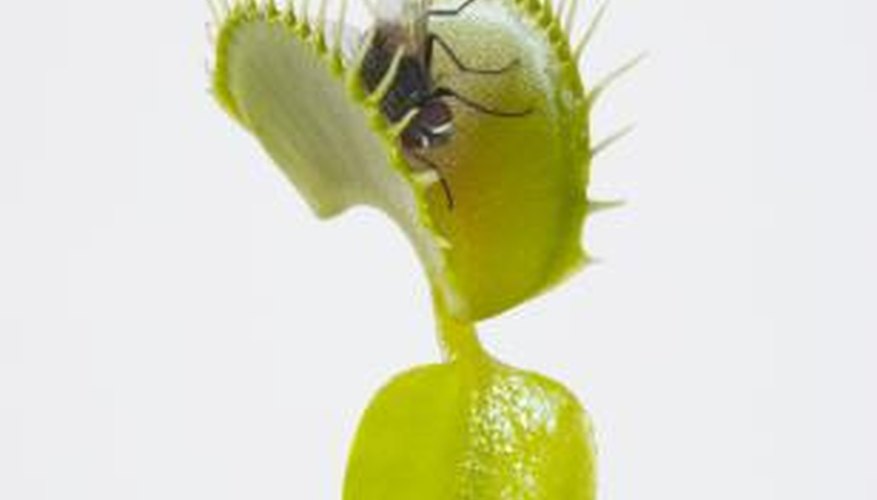The Venus flytrap, Dionaea muscipula, native to North Carolina, bears the distinction of being the world's fastest-moving plant. A flytrap snaps shut in a fraction of a second, closing its spiked jaws on its living prey, according to professor Wayne Armstrong of Palomar College. The plant oozes digestive juices in the same way a human stomach does. It breaks down the insect's body and feeds on it for nitrogen. When the trap reopens, the insect's exoskeleton --- the external structure --- blows away or gets washed off by rain. Learn the parts of the Venus flytrap so you can label a diagram, terrarium, science project or show plant.
- The Venus flytrap, Dionaea muscipula, native to North Carolina, bears the distinction of being the world's fastest-moving plant.
- Learn the parts of the Venus flytrap so you can label a diagram, terrarium, science project or show plant.
Examine the parts of the Venus flytrap plant in a book or on a website, or look at the plant in person if you have one.
Draw a line lightly in pencil next to each part of the plant on your poster or diagram --- or on each label, if you're using labels. Use a ruler to make straight lines so your lettering will be straight.
Print the name of each part neatly in pencil. The Venus flytrap's parts consist of the trap --- a two-lobed blade --- cilia, trigger hairs, petiole, leaves, rhizome and roots. Use a marking pen to write over the pencilled lettering to make the labels bold and easy to read.
Label the trap (the part that catches the insect) "Two-Lobed Blade." Each half of the trap is a lobe. The trap is also called a leaf blade or lamina.
- Draw a line lightly in pencil next to each part of the plant on your poster or diagram --- or on each label, if you're using labels.
- Label the trap (the part that catches the insect) "Two-Lobed Blade."
Label the trap's teeth (the spikes at the edges of the lobes) "Cilia." The cilia interlace when the trap snaps shut.
- Label the trap's teeth (the spikes at the edges of the lobes) "Cilia."
Label the hairs inside the trap "Trigger Hairs." A moving insect touching two hairs triggers the trap to snap shut and trap the insect, states Armstrong.
Label the flat stalk below the trap "Petiole." This part of the Venus flytrap plant connects the two parts of the Venus flytrap leaf: the lower leaf and the two-lobed blade trap.
Label a leaf at the base of the Venus flytrap "Leaf," or, to refer to the base of the plant, "Leaf Base." The lower leaves nourish the plant via photosynthesis the same way regular plants do.
Label the part of the Venus flytrap below the growing medium "Rhizome." The rhizome is a bulblike structure at the base of the plant.
Label the area below the rhizome "Roots." The Venus flytrap has small roots.
TIP
Venus flytraps prefer a moist environment. They do well in a terrarium in bright, indirect light. If you bought one in a store and want to leave it in the pot, keep the plastic cover on it to keep in moisture. Venus flytraps reproduce from the rhizome, according to the Botanical Society of America. If the plant has more than six leaves, it's producing a new plant. You can split it off from the parent plant to grow a separate Venus flytrap. The plants exude fragrant nectar to attract insects to the trap.
WARNING
If you work with a live Venus flytrap plant, don't tease it. Causing the traps to close too much will kill the plant. Do not feed meat to your carnivorous plants.
